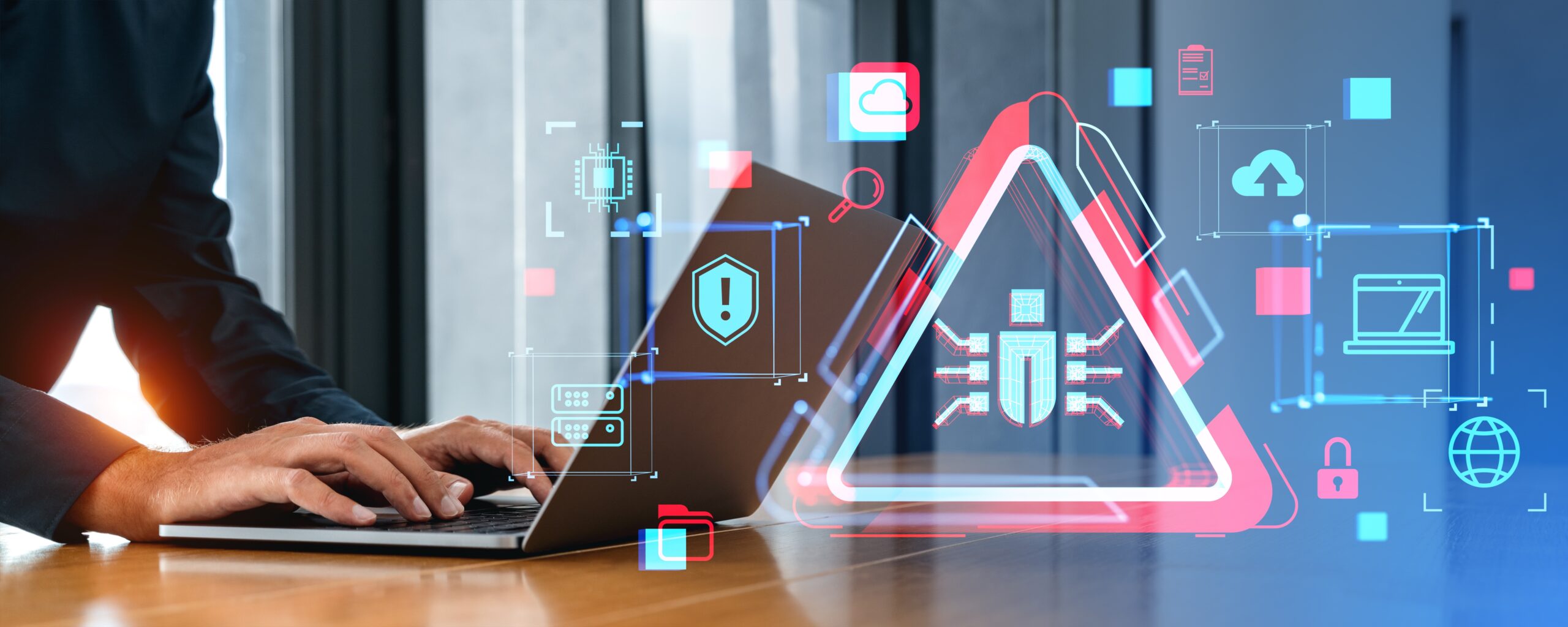Endpoint Detection & Response (EDR)
Detecting and removing threats before they cause harm

Endpoints like computers, phones, and servers are key targets for cyber criminals.
Endpoints such as computers, phones, and servers are key targets for cyber criminals. Most breaches start on an endpoint. Detecting and removing malware and stopping attacks before they cause harm is key to preventing the downtime, lost revenue, and upset of cyber attacks.
If cyber criminals can infiltrate an endpoint, they can then encrypt it with ransomware for extortion or move laterally in search of private data, intellectual property, or financial systems.
Hybrid working means we are more dependant on endpoints than ever before. You need to enable home working without adding cyber risk if you are to recruit and retain high calibre teams.
What is Endpoint Detection & Response (EDR)?
Endpoint Detection and Response (EDR) is a cyber security solution designed to continuously monitor an organisation’s endpoint activity across devices such as computers, mobile devices, and servers. It detects, investigates, and responds to potential threats, providing threat intelligence that helps security teams understand how attacks occur and how to prevent future incidents.
By giving visibility into activities happening at the endpoint, EDR enables security teams to detect suspicious activity that may have otherwise gone unnoticed. It also contains threats before they spread across the network, and guides security teams on how to respond effectively.
What does Endpoint Detection & Response (EDR) do?
EDR systems continuously monitor and record endpoint activity, providing real-time visibility into endpoint activity across the network. Using advanced data analytics, these solutions detect suspicious activity and automatically block malicious behaviour. They alert security teams when manual intervention is required to address potential threats before they can cause further harm.
Endpoints are typically the target for cyber criminals. In today’s landscape it is necessary to ensure there are no gaps in your security posture. Therefore, EDR fills the gaps left by traditional antivirus solutions, offering complete protection, detection, and response capabilities.
Why do you need Endpoint Detection & Response (EDR)?
EDR’s automatic response capability ensures that threats can be addressed quickly, minimising downtime and damage. It is especially effective against more sophisticated threats, offering real-time visibility that is crucial for threat intelligence and proactive threat hunting. These offer insights beyond the capabilities of traditional security solutions. As a result, EDR solutions provide better incident forensics, allowing security teams to understand how an attack occurred, providing awareness to address root causes and prevent future instances.
As part of the SOC triad – Network Detection and Response (NDR), Endpoint Detection and Response (EDR), and Security Information and Event Management (SIEM) – EDR is an essential cyber security solution for comprehensive protection. Together, these technologies give security teams the tools to detect suspicious activity and take immediate action to protect the organisation.
For businesses with remote workers, EDR provides a critical line of defence. It allows quick isolation of compromised devices to limit damage, making it an indispensable tool for securing modern, distributed work environments. Using a managed EDR service further enhances security by ensuring constant monitoring and response without overburdening in-house security teams.
What are Endpoint Detection & Response (EDR) features?
Creating blocklists and allowlists to control what applications and/or activities are permitted on the network. Collecting data from all endpoints into one centralised system for better analysis and threat intelligence. Complete visibility into endpoint activity to help detect and investigate potential risks. Automated data collection and processing to generate an appropriate response, ensuring fast remediation. Based on predefined rules, EDR helps guide remediation and security teams responses during an attack. EDR supports proactive investigations by security teams to uncover hidden threats.
Organisations can leverage a managed EDR service to outsource the management of their EDR solution to external experts, ensuring continuous protection and threat detection without overwhelming internal teams. See an overview of our EDR service below.
The Antivirus Software replacement
Antivirus software stops malware with known signatures. But cyber criminals now use more sophisticated techniques than ever before, so a better way of seeing and stopping new threats is needed.
Endpoint Detection & Response (EDR) goes far beyond traditional antivirus software. It looks for, and stops, threats that use previously unseen signatures, and other devious attacks like memory-resistant malware that cover their tracks and try to block their own removal.
EDR has another key advantage over antivirus software – the ‘R’ in ‘EDR’ – Response.
In the event of an attack like Ransomware reaching its target and encrypting endpoints, the Response in EDR kicks in and takes swift action:
- EDR identifies the malware and prevents it from moving to the wider network
- The Ransomware is removed from all affected endpoints
- The endpoints and data are returned to their pre-attack status
This all happens in a matter of minutes. It ensures swift resolution and prevents repeat attacks.

Contact us today to discuss your needs
Managed Endpoint Detection & Response (EDR): Responding to the IT and security skills gap
Companies are struggling to keep up with the growing frequency and sophistication of cyber attacks. Managing the technology needed to address this threat landscape is another challenge.
Our Red Helix Endpoint Detection & Response Managed Service eases the strain from in-house teams by combining the best EDR technology with our dedicated SOC (Security Operations Centre) Analysts to deliver a vital, early detection and response service.
We will support your Company and IT Teams by:
- Removing the complexity of configuring your EDR platform to your needs
- Ensuring your new endpoints are always discovered and protected
- Supporting your teams and responding to attacks and anomalies

How to pick the right Endpoint Detection & Response (EDR) tool for you
Know your organisation’s needs
You need to understand which endpoints you need to protect (e.g., laptops, servers, mobile devices), and the number of endpoints you need to protect whether this is on-premise, or cloud based.
Ensure compliance
Your tool must be compliant with industry regulations such as GDPR and PCI-DSS.
Features of the tool
It is necessary that your tool includes threat detection, behavioural analysis, automated remediation, and threat hunting.
Check for integration capabilities
Your EDR tool must integrate with your Security Information and Event Management (SIEM), threat intelligence platform, firewalls, antivirus systems, etc.
Assess its ease of use
Does it have user-friendly dashboards for monitoring?
Are there reporting capabilities to provide insights?
Are there options for automation to reduce the burden on your IT security team?
Evaluate its performance
Ensure that your tool doesn’t slow down endpoints and provides real-time updates without interrupting operations.
Consider support
Your vendor should offer 24/7 support, detailed documentation and training, as well as regular updates and patching.
By carefully evaluating these factors you can correctly chose an EDR solution that provides robust endpoint protection tailored to your organisation’s needs.
| CrowdStrike | Microsoft Defender |
|---|---|
| Can be deployed instantly with a single, lightweight agent, enabling instant protection. | Deployment is complicated as all endpoints require the premium edition of the latest version of Windows and require upfront OS and hardware upgrades for full security functionality. |
| Automatically updates as new software and/or patches are released. | Frequent reboots, and daily signature updates. |
| Advanced threat detection via AI, behavioural IOAs, and industry leading threat intelligence. | Adversaries can easily bypass Microsoft security products due to its outdated signature-based AV. |
| No hidden costs. Transparent licensing which is easy to budget and simplifies operations. | Costly due to platform maintenance, and complex licensing, therefore requiring additional dedicated staff. |
| A single, unified console and customisable workflow automations which offers comprehensive attack visibility, real-time threat context, and accelerated investigation across endpoints, cloud, identity, and more. | Disjointed user experience due to usage of multiple consoles, which creates security risks and slows response time. |

CrowdStrike Powers our EDR Services
As a recognised partner of CrowdStrike, Red Helix leverages this relationship to provide services that keep organisations safe from the most prevalent and persistent threats. Our expertly managed services, underpinned by CrowdStrike Falcon, ensure continuous threat detection, real-time monitoring, and rapid incident response without the need for an in-house security team.
Find out more


